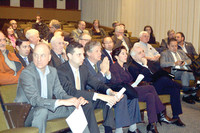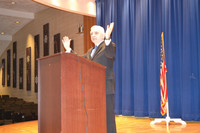By TIM FORSBERG -- Warwick school officials joined in applauding Senator Jack Reed at Johnston High School last Friday as he talked about legislation he introduced last August for $100 billion in federal funds to repair the nation's school systems.
This item is available in full to subscribers.
We have recently launched a new and improved website. To continue reading, you will need to either log into your subscriber account, or purchase a new subscription.
If you are a current print subscriber, you can set up a free website account by clicking here.
Otherwise, click here to view your options for subscribing.
Please log in to continue |
|


Warwick school officials joined in applauding Senator Jack Reed at Johnston High School last Friday as he talked about legislation he introduced last August for $100 billion in federal funds to repair the nation’s school systems.
“We are here because we understand that we have to have safe, modern, and healthy schools for Rhode Island. It’s for the welfare of the children and it’s for the future of this state and this country. This is a great community and it’s a wonderful school here, but earlier this week had burst pipes and a maintenance crisis,” said Reed.
“They got it straightened out because of the leadership of the mayor and his colleagues here in the schools, but these last few weeks have highlighted again the need to modernize and fix our schools all across the country.”
According to Sen. Reed’s office, high-quality, safe, and modern school facilities support and enhance the health, well-being, and learning experience of the over 50 million students who attend public schools, the six million staff who work in schools, and the neighborhoods and environments where they are located.
“States and local communities need the help. My legislation would create direct grants to states to modernize schools, particularly in our highest need communities,” said Reed. “It will also help improve school infrastructure by authorizing bonds so that borrowing by local communities and states would be more affordable.”
Reed’s information cited a 2014 Department of Education study, which estimated that it would cost $197 billion to bring all public schools into “good” condition. Nationally, there is also a $38 billion funding gap in annual capital construction and new facility funding, as reported in the 2016 State of Our Schools report. Also highlighted was the fact that K–12 facility infrastructure is an important part of the construction economy, accounting for nearly a quarter of state and local infrastructure investments, second only to highways. However, federal funding accounts for 0.2 percent of the total current capital investment in schools.
“The Trump administration is going to propose an infrastructure bill. I believe that the federal government has to be a partner with the state and local governments to fix our schools,” said Reed. “I’m looking at a bipartisan effort to include school infrastructure in the infrastructure bill to provide resources to local communities to fix the schools.”
Reed’s bill, The School Building Improvement Act of 2017 would provide a total of $100 billion in direct grants and school construction bonds over 10 years to help fill the $38 billion annual gap in school facility capital construction need.
“This is truly a special day, no doubt about it. As we gather here today to gather some very important information of federal legislation that will be sponsored by our own Sen. Jack Reed and his colleague Sen. Sherrod Brown from Ohio,” said Johnston Mayor Joseph Polisena, who hosted the forum in the high school’s auditorium.
The School Building Improvement Act would provide formula funding to states for local competitive grants for school repair, renovation, and construction. These grants focus assistance on states and communities with the greatest financial need, would encourage green construction practices, establish equitable access for public charter schools, contain state matching criteria, and outline permissible criteria for spending. Projects also require the use of American-made iron, steel, and manufactured products.
In addition, the measure would provide $30 billion for qualified school infrastructure bonds, create a comprehensive study of the physical condition of public schools at least once every five years, and provide a temporary increase of $100 million for Impact Aid construction.
“You don’t realize all the costs that we incur by just putting these Band-Aids on. We’re taking this seriously, enough is enough. We have over a billion dollars of need to rebuild our school buildings,” said Governor Gina Raimondo during the forum. “Too many of our school buildings get a failing grade, they don’t even pass the basic standard of warm, safe and dry.”
Raimondo stated that she’s prepared to make a “big investment” in Rhode Island, and on Tuesday during her State of the State talked about a $1 billion for education over five years. [The $1 billion is a compilation of state annual funding, bonds and municipal spending]. She cited the Jacobs report, a report published last summer that found that there were $2.2 billon dollars worth of repairs needed for Rhode Island schools to bring them to modern levels.
“We’re going to be judged by what we do for our kids and the promises and dreams that we have for them, and I think it’s time to step up. The treasurer and I have been working hard on this and next week when I put my budget into the General Assembly I’m going to be proposing a bold, once in a generation investment in our schools and I’m going to ask the legislature to put a bond on the ballot and I believe the people of Rhode Island are going to do the right thing,” she said.
The governor’s office said Wednesday that a $250 million bond would be proposed for the November ballot.
The statewide report by Jacobs Engineering Group Inc. assessed every school building and reported that approximately $190 million-worth of work is needed to bring Warwick’s public schools into the modern era of safety and efficiency.
Superintendent Philip Thornton, who was present with mayors, town administrators, and superintendents from across the state, saw the need for increased funding.
“It’s great to hear that people are paying attention to this because it’s not a new problem in Rhode Island, and schools have been spending every year dealing with this for decades. It almost seems like a week won’t go by where we won’t have a facilities problem, whether it’s a roof or a boiler,” he said.
Thornton referenced the roofs at Lippitt Elementary and John Brown Francis that are past their useful life as examples. He stated that temporary measures taken to address the problems were just that, and that long term fixes were needed, not just patchwork.
“This is the world in which we live right now, so this is a great conversation to have a federal component, a state component, and a local component. Locally we’re meeting on the 22nd of January with the city council to hopefully have them authorize for the voters an $85 million bond for the local,” said Thornton. “Eighty-five million is only 45 percent of what the state said we should be doing. We say, given the other challenges in the city, such as the sewers, we figure the $85 million is fiscally responsible.”
The superintendent added that the schools approach the council for approval on eight to ten projects a year. He said that the district has approximately a dozen fire alarm systems that function but need to be replaced. He explained that certain school boilers need to be replaced, along with windows, door frames, possible asbestos abatement issues, paving, electrical and gas systems, and more, and that the costs to fix are expensive.
“I think they’re big numbers and people sometimes have a hard time wrapping their head around them, but you can either pay it now or pay it later when the costs will be bigger,” said Thornton.
1 comment on this item Please log in to comment by clicking here
wwkvoter
Rundown schools are just plain wrong.
Saturday, January 20, 2018 Report this